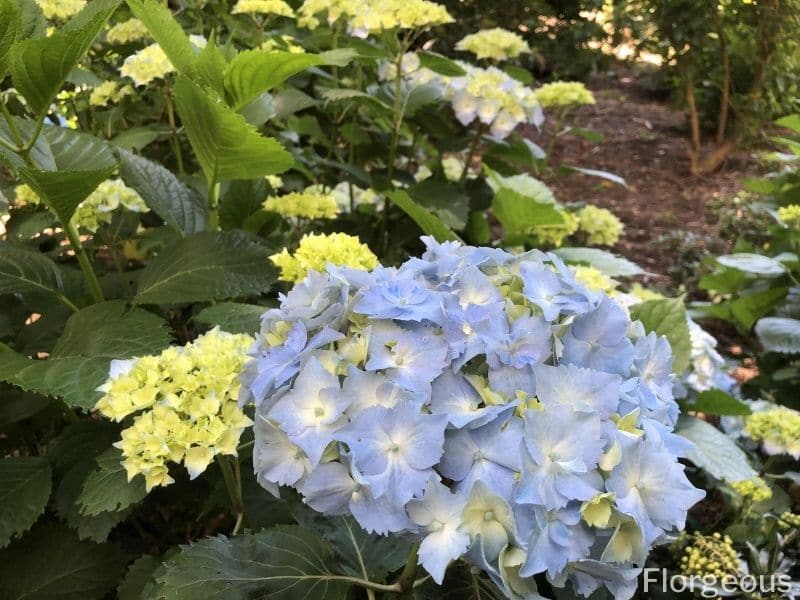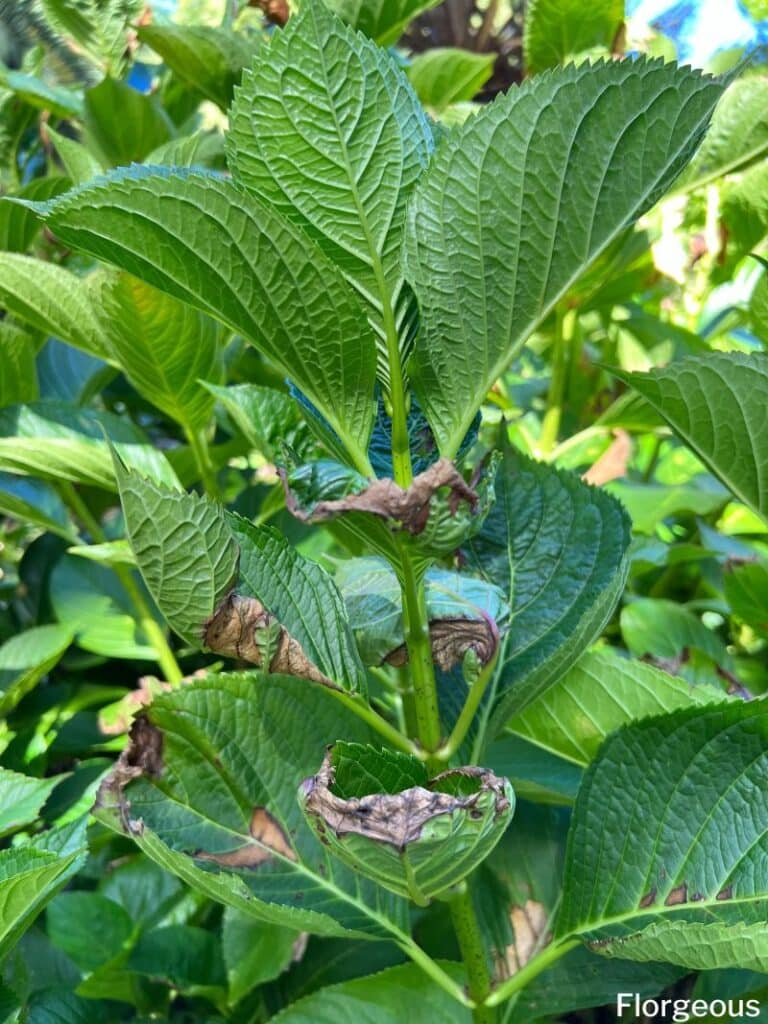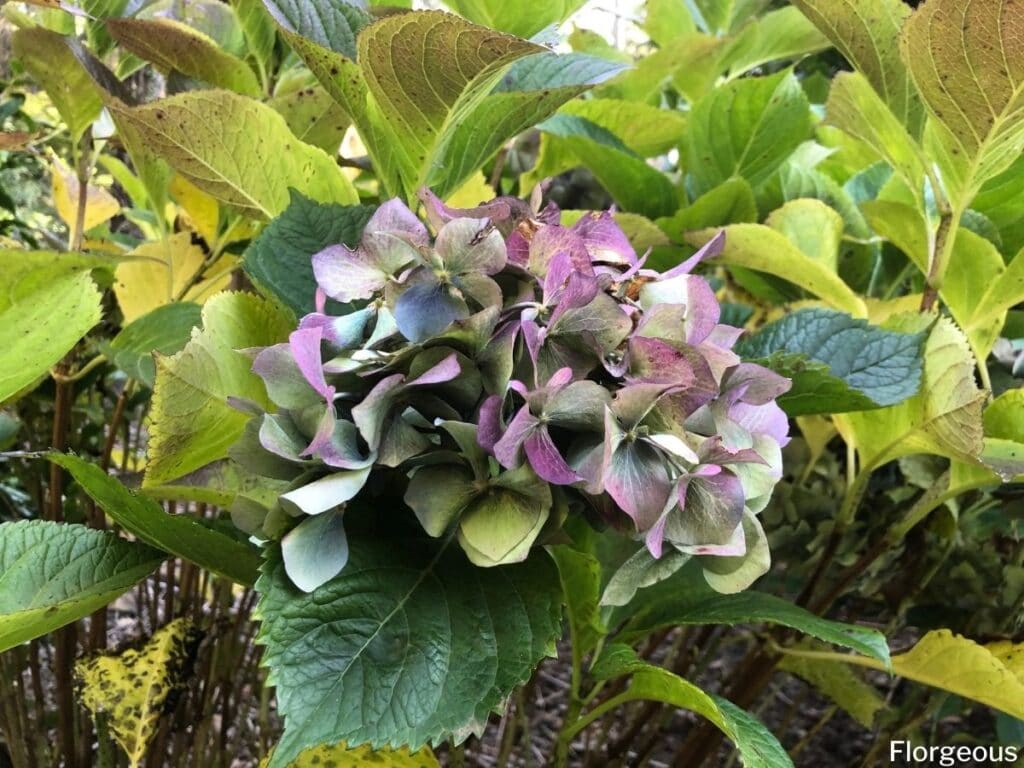Although there are all kinds of culprits that can cause common problems with hydrangea leaves, more often than not, issues with the foliage are directly related to fungal diseases.
When it comes to growing hydrangeas successfully, there are a few diseases to watch out for, but keep in mind that something as simple as underwatering or a pest infestation can cause your leaves to wilt and drop from the plant.
Here are some issues to keep an eye out for when your hydrangea leaves turn purple, black, brown, white, red and yellow.
Why Are the Leaves Dying on My Hydrangea?
There are a few reasons why the foliage on your shrub might die.
Although hydrangeas aren’t necessarily finicky plants, they do occasionally run into problems.
If you’ve just planted your shrub in the garden or transplanted it into a new container, relax – your plant might just be suffering from a bit of transplant shock. Keep it well watered and monitor the leaves for a few weeks. Give it time to bounce back and protect it as best as you can from the harsh elements (like excessive sunlight or wind).
However, know that browning, burned foliage can also be symptoms of excess fertilizer. Hydrangeas aren’t heavy feeders, so using too much fertilizer for applying it too often can also lead to problems.
Some pests and diseases can also cause your hydrangeas’ leaves to wither, decay, or become discolored. It’s important to keep a lookout for common problems so that you can address them as soon as they are detected.

Here are some of the most common issues you may encounter with the leaves of your hydrangea shrub.
1. Brown Spots on Hydrangea Leaves
If you notice spots on the foliage of your shrub, pay close attention to their patterns and colors.
Brown spots (can also be purple, dark, black or red spots) are usually indicative of a bacterial or fungal infection. The fungus or bacterial diseases don’t usually kill the plant, but they can weaken it over time. Of course, they also aren’t the most attractive.
You might notice them appearing at cooler periods, like at the beginning of fall. If you see leaf debris on the foliage, it could be a sign of fungal leaf spots caused by anthracnose or Cercospora leaf spot.
Cercospora is perhaps the most common and causes brown or purple spots to appear at the base of the plant. These spots on the leaves are small, occasionally exhibiting brown or purple halos.
Anthracnose can cause the leaves to turn fully yellow and then fall off the plant, leaving behind a pile of dead flowers and fallen leaves. Anthracnose can also cause pale brown spots to appear – the main difference between this disease and Cercospora is that anthracnose also causes spots on flowers.
You can address both with a fungicide, but it’s far easier to prevent fungal diseases by ensuring proper spacing and air circulation (which can be accomplished by pruning hydrangea plants and limiting your overhead watering).
The bacterial leaf spot can be harder to pinpoint. These usually start at the base of the plant, on the lower foliage, and can be purple, dark brown, or even red in color. Fungal leaf spots may appear after coming into touch with fading, diseased petals, and flower buds may perish before they can open.
You can use a bactericide but often, fertilizing hydrangea is a good way to help your plant bounce back. A dose of compost tea can be helpful, as can pruning to get rid of the dead and dying leaves.
2. Yellowing Hydrangea Leaves
This is another typical leaf disease that affects smooth hydrangea, panicle hydrangea, oak leaf hydrangea, and bigleaf hydrangea.
If the foliage of your hydrangea is turning yellow, it is usually indicative of a problem with the roots – especially if the leaves then fall off the plant.
If your plant was allowed to become too dry, too wet, or overfertilized, it’s likely that the roots will be damaged due to improper soil moisture. When the roots are damaged, the leaves will wilt, turn yellow, and fall from the plant.
Adjust your watering technique (depending on whether you over-or under-watered), and if you can, repot the hydrangea into a container with fresh, well draining soil.
3. Brown Edges

As we mentioned earlier, hydrangea blooms are particularly vulnerable to excess nutrients. Therefore, if you notice both yellowing leaves and browning edges, that’s a good indication that you burned the plant with too much fertilizer.
Flush the soil with water, regardless of whether it’s growing in the ground or a container. This will remove fertilizer salts. Keep flushing until the diseased plant appears healthy, and hold off on additional fertilizing for a few weeks.
4. Rust
Rust is a disease that presents much differently than many of these other common problems with hydrangea foliage. It spreads when water splashes on leaves and causes orange spots on the bellies of leaves. Eventually, these leaves can turn brown or yellow and fall off the plant.
You can remove the infected leaves, but addressing your watering technique is essential to prevent it in the future. If the infection is severe, you can use a fungicide specifically for hydrangea rust to treat infected plants.
Learn about other diseases of hydrangeas, such as root rot or spider mites.
5. Powdery Mildew
Powdery mildew is easy to identify because it looks just like a grey, powdering coating on the foliage. Another common fungal disease, it can be prevented by proper air circulation and watering techniques. Water in the morning and use a fungicide or an organic treatment like neem.
6. Drooping Leaves
Last but not least, drooping leaves are a common issue with hydrangeas and can be caused by several factors. One primary cause is underwatering, where the plant’s roots are not receiving enough moisture to support proper leaf turgidity.
On the other hand, overwatering can lead to root rot, inhibiting the plant’s ability to take up water and resulting in drooping foliage.
Additionally, environmental stressors such as intense heat or direct sunlight can cause leaves to wilt and droop. Ensuring adequate watering, providing shade during hot periods, and maintaining well drained soil can help alleviate drooping leaves and promote the health of hydrangea plants.
How Do You Treat Leaf Diseases on Hydrangeas?
To treat leaf hydrangea diseases, start by removing and disposing of affected leaves to prevent the spread of infection. Improve air circulation around the plants by using pruning shears to cut nearby branches and avoid overcrowding.
Next, fill a spray bottle with fungicides labeled for use on hydrangeas, following the manufacturer’s instructions carefully. Organic options such as neem oil or copper-based fungicides can help control fungal infections. In addition, chemical treatments can be used to combat bacterial and viral diseases.
Additionally, ensure proper watering practices, avoiding overhead irrigation to minimize moisture on the leaves. Consistent monitoring and prompt treatment of leaf diseases are essential for maintaining the health and vitality of hydrangea plants.
Finally, when selecting what to plant near hydrangeas, make sure those companions won’t cause any further problems for your hydrangea plants.
FAQs
What do overwatered hydrangea leaves look like?
Overwatered hydrangea leaves may appear wilted, yellowing, or have brown spots. They may also become mushy or translucent. Excessive moisture can lead to root rot, causing symptoms similar to drought stress.
Why are my hydrangea leaves turning brown and curling?
Brown and curling hydrangea leaves can indicate several issues, including underwatering, overwatering, or environmental stress. Inconsistent watering, hot weather, or too much sun can cause leaves to brown and curl.
How do you fix brown leaves on hydrangeas?
To fix brown leaves on hydrangeas, identify and address the underlying issue, which could be related to watering, sunlight, or nutrient deficiencies. Ensure the plant receives consistent moisture, provides morning sun during hot periods, and prune away any dead or damaged foliage. Applying a balanced fertilizer can also help promote healthy leaf growth.
What does hydrangea fungus look like?
Hydrangea fungus can manifest in different ways, depending on the specific fungal infection. Common symptoms include gray or white powder patches on the leaves, brown or black spots, or the darkening and wilting of affected foliage. Some fungal infections may also cause the leaves to develop irregular shapes or curls.
Final thoughts
Hydrangeas are beautiful and popular plants that can be affected by a variety of leaf problems. Some common hydrangea leaf problems include yellow leaves, fungal spots, bacterial spots, and powdery mildew.
To prevent these problems, it’s important to maintain proper watering practices, avoid overhead irrigation, and ensure good air circulation around the plants. Prompt treatment of leaf diseases and root rot is essential for maintaining the health and vitality of hydrangea plants.
By following these tips, you can keep your hydrangea plant looking healthy and vibrant throughout the growing season. Remember to always consult with a professional if you have any concerns about your plants’ health.







